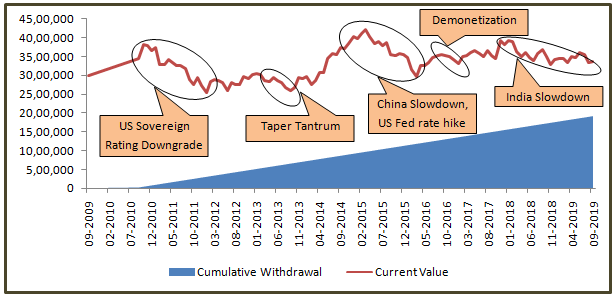Mutual Fund Systematic Withdrawal Plan: A smart long term income solution

When investors want regular income from their investments the automatic choices for many are bank term deposits or post office monthly income scheme. However, declining interest rates have caused many investors to be worried about meeting their income needs from traditional savings schemes. In the current economic environment interest rates are expected to fall further and investors may be looking for alternative long term income solutions.
Over the last 4 – 5 years with growing popularity of mutual funds among retail investors, dividend paying schemes have attracted a lot of investor interest. Several mutual schemes have maintained good monthly dividend pay-out track records over the last few years and are seen as good investment options for regular income. However, investors should know that mutual fund dividends are paid at the discretion of the fund house and are not guaranteed unlike FD monthly interest.
Investors should understand that as per SEBI regulations, dividends can paid only from the accumulated profits of a scheme. In a prolonged market downturn, schemes which continue to pay regular dividends, may deplete their reserve of accumulated profits and may not be able to declare dividends until conditions improve.
It is also important for investors to understand the tax implications of mutual fund dividends. A tax change was introduced in 2018 Union Budget for equity mutual fund dividend options. Prior to 2018, dividends paid by equity or equity oriented funds were tax-free but from FY 2018 – 19 onwards, AMCs will have to pay 10% dividend distribution tax (DDT) before paying dividends to investors (individual or HUF). In the case of debt funds, the AMCs have to pay 29.12% DDT before paying dividends to investors (individual or HUF).
Systematic Withdrawal Plans is a smart investment option for investors who need regular income from their investments because of the following reasons -
- It gives fixed cash-flows to investors till the time they have sufficient unit balance. Unlike mutual fund dividends, you can decide how much cash-flow you want to receive.
- For reasonably low rates of withdrawals, you can get both regular cash-flows as well as capital appreciation. Mutual fund returns in the long term are usually much higher than traditional savings products.
- Systematic Withdrawal Plans is one of the most tax efficient income solutions for investors.
What is Systematic Withdrawal Plan?
In Systematic Withdrawal Plan (SWP), you can draw a fixed amount from your mutual fund investment at a specified frequency (monthly, quarterly, annual etc); you can specify the day of the month when the withdrawal should be made and the amount will be credited directly to your bank account on the specified day. You can continue your SWP as long as there are balance units in your mutual fund scheme account.
How does Systematic Withdrawal Plan work?
Systematic Withdrawal Plan generates cash-flows (income) for investors by redeeming units of mutual fund scheme at specified intervals. The number of units redeemed to generate cash-flows in an SWP depends on the SWP amount and the scheme Net Asset Values (NAV) on the withdrawal dates. In an SWP, your unit balance will diminish over time, but if the NAV grows at a faster rate than your withdrawal rate in the long term, then your investment value will be higher resulting in capital appreciation, intermittent volatility not with standing.
SWP from LIC MF Multicap Fund
In stock market, we have both periods of both rising market and falling market. Let us see how SWP works over a sufficiently long period of time across different conditions (bull markets and bear markets).
In the example below, we will see the results of a monthly SWP from LIC MF Multicap Fund over the last 10 years. The last 10 years saw recovery from 2008 financial crisis, followed by 2011 crash due US rating downgrades, volatility due to taper tantrum in the US, pre and post-election rally (Modi Government) in 2014, correction in 2015 due to China slowdown, Brexit and Fed rate hike fears, recovery in 2016 followed by bull market in 2017 and finally volatility in 2018 – 19 due to economic slowdown fears. Let us see how SWP from LIC MF Multicap Fund performed during this period -
Let us assume you invested Rs 30 lakhs in LIC MF Multicap Fund (Growth Option) on September 1, 2009. Your monthly SWP amount was Rs 17,500 (average annual withdrawal rate of 7%) and that your withdrawal date is the 1st of every month. Let us assume that you began your SWP from September 1, 2010 in order to avoid short term capital gains tax and exit load.
In Advisorkhoj, we have developed an SWP calculator; we urge you to use our calculator, if you are planning an SWP, to get a sense of historical SWP performance of different schemes. We will present the results of the LICMF Multicap Fund SWP example in a chart format; to see detailed results, please use our tool.

Source: Advisorkhoj SWP Calculator
You can see that, despite making regular withdrawals (cumulative withdrawal of more than Rs 19 lakhs in the last 7 years), the current investment value (as on September 16, 2019) is over Rs 33 lakhs. You would have had a capital appreciation of Rs 3 lakhs despite regular withdrawals.
How did we get such impressive results?
Equity though volatile, is one of the best performing asset classes in the long term. In the last 10 years, Nifty 500 TRI, the broad based market index gave nearly 10% CAGR returns. This is higher than returns of other asset classes. Superior long term returns of equity as asset class make mutual fund SWP better long term income solutions compared to FDs and other traditional savings avenues.
The second important factor was that, our withdrawal rate was not excessively high. If your withdrawal rate is higher than the average rate of return on investment over a certain period, then you may end up with less than what you invested. In fact, in our view, you should adopt a conservative approach to withdrawal, because capital markets can be unpredictable. There are no hard and fast rules as to what constitutes a reasonable withdrawal rate. In our view, your withdrawal rate should be your FD interest rate on a pre-tax basis. That way you will have higher cash-flows compared to FDs due to tax advantage enjoyed by equity or equity oriented hybrid mutual funds. At the same time, you may also potentially enjoy some capital appreciation due to superior long term equity performance.
Tax Advantage
Interest income from FD and most post office small savings schemes are taxed as per the income tax rate of the investor. SWP from equity / equity oriented mutual funds are subject to capital gains taxation. Withdrawals made within 1 year of investment are subject to short term capital gains tax @15%. Capital gains arising out of withdrawals made after 1 year of investment are tax free up to Rs 1 lakh of capital gains per year. Long term capital gains in excess of Rs 1 lakh are taxed at 10%. The beneficial tax treatment makes SWP one of the ideal long term income solutions.
Conclusion
In this blog post, we discussed about various aspects of Systematic Withdrawal Plans. SWP is a smart and convenient option for getting predictable cash-flows from your investment; at the same time, there are multiple considerations that you need to be aware of, to get the desired results from your SWP. If you need regular income from your investments, you should discuss Systematic Withdrawal Plan or SWP option with your financial advisor.
Mutual Fund Investments are subject to market risk, read all scheme related documents carefully.
RECOMMENDED READS
LATEST ARTICLES
- LIC MF Money Market Fund: Good investment option for parking your idle funds
- LIC MF Small Cap Fund: A promising small cap fund for long term investors
- LIC MF Dividend Yield Fund: A suitable diversified equity in current market dynamics
- LIC MF Value Fund: A good fund for volatile markets
- LIC MF Focused Fund: Potential of creating alphas over long investment horizons
LIC Mutual Fund was established on 20th April 1989 by LIC of India. Being an associate company of India's premier and most trusted brand, LIC Mutual Fund is one of the well known players in the asset management sphere. With a systematic investment discipline coupled with a high standard of financial ethics and corporate governance, LIC Mutual Fund is emerging as a preferred Investment Manager amongst the investor fraternity.
Investor Centre
Follow LIC MF
More About LIC MF
POST A QUERY






